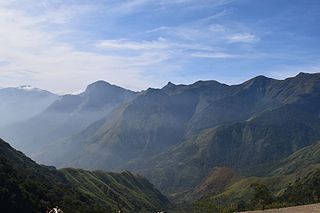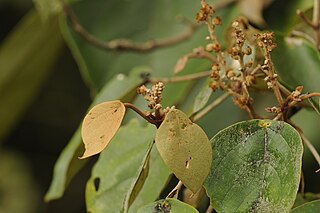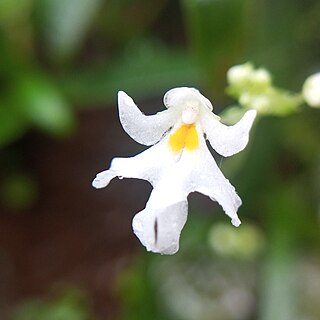
The Western Ghats, also known as the Sahyadri, is a mountain range that stretches 1,600 km (990 mi) along the western coast of the Indian peninsula. Covering an area of 160,000 km2 (62,000 sq mi), it traverses the states of Gujarat, Maharashtra, Goa, Karnataka, Kerala, and Tamil Nadu. The range forms an almost continuous chain of mountains along the western edge of the Deccan Plateau, from the Tapti River to Swamithoppe in Kanyakumari district at the southern tip of the Indian peninsula. The Western Ghats meet with the Eastern Ghats at Nilgiris before continuing south.

Impatiens is a genus of more than 1,000 species of flowering plants, widely distributed throughout the Northern Hemisphere and the tropics. Together with the genus Hydrocera, Impatiens make up the family Balsaminaceae.

Silent Valley National Park is a national park in Kerala, India. It is located in the Nilgiri hills and has a core area of 89.52 km2 (34.56 sq mi). It is surrounded by a buffer zone of 148 km2 (57 sq mi). This national park has some rare species of flora and fauna. Silent Valley National Park was explored in 1847 by the botanist Robert Wight. It is located in the border of Mannarkkad Taluk of Palakkad district, Nilambur Taluk of Malappuram district, Kerala, and Nilgiris district of Tamil Nadu.

Mudumalai National Park is a national park in the Nilgiri Mountains in Tamil Nadu in southern India. It covers 321 km2 (124 sq mi) at an elevation range of 850–1,250 m (2,790–4,100 ft) in the Nilgiri District and shares boundaries with the states of Karnataka and Kerala. A part of this area has been protected since 1940. The national park has been part of Nilgiri Biosphere Reserve since 1986 and was declared a tiger reserve together with a buffer zone of 367.59 km2 (141.93 sq mi) in 2007. It receives an annual rainfall of about 1,420 mm (56 in) and harbours tropical and subtropical moist broadleaf forests with 498 plant species, at least 266 bird species, 18 carnivore and 10 herbivore species. It is drained by the Moyar River and several tributaries, which harbour 38 fish species.

Mukurthi National Park (MNP) is a 78.46 km2 (30.3 sq mi) protected area located in the western corner of the Nilgiris Plateau west of Ootacamund hill station in the northwest corner of Tamil Nadu state in the Western Ghats mountain range of South India. The park was created to protect its keystone species, the Nilgiri tahr.
Colonel Richard Henry Beddome was a British military officer and naturalist in India, who became chief conservator of the Madras Forest Department. In the mid-19th century, he extensively surveyed several remote and then-unexplored hill ranges in Sri Lanka and south India, including those in the Eastern Ghats such as Yelandur, Kollegal, Shevaroy Hills, Yelagiri, Nallamala Hills, Visakhapatnam hills, and the Western Ghats such as Nilgiri hills, Anaimalai hills, Agasthyamalai Hills and Kudremukh. He described many species of plants, amphibians, and reptiles from southern India and Sri Lanka, and several species from this region described by others bear his name.

Sispara, സിസ്പാര, a proper noun, is a combination of the Badaga language words si:su + pore; meaning: magnetite bearing rock + gorge. It may refer to:

Carissa spinarum, the conkerberry or bush plum, is a large shrub of the dogbane family (Apocynaceae), widely distributed in tropical regions of Africa, Southern Asia, Australia, and various islands of the Indian Ocean. It is most well known in Australia, where it is also called currant bush or, more ambiguously, native currant or even black currant. It is, however, neither closely related to plums (Prunus) nor to true currants (Ribes), which belong to entirely different lineages of eudicots. In India, it is also called wild karanda/wild karavanda, referring to the related karanda. Carissa spinarum is often discussed under its many obsolete synonyms.

Hopea is a genus of plants in the family Dipterocarpaceae. It contains some 113 species, distributed from Sri Lanka and southern India to the Andaman Islands, Myanmar, southern China, and southward throughout Malesia to New Guinea. They are mainly main and subcanopy trees of lowland rainforest, but some species can become also emergent trees, such as Hopea nutans.

Lasianthus is a genus of flowering plants in the family Rubiaceae. They are tropical subshrubs, shrubs, or rarely, small trees. They inhabit the understory of primary forests.

Indrella is a monotypic genus containing the single species Indrella ampulla, a tropical terrestrial air-breathing gastropod mollusk in the family Ariophantidae. It is endemic to the Western Ghats of India.

The Mhadei Wildlife Sanctuary is a 208.5-km2 (80.5-mi2) protected area in the Indian state of Goa in the Western Ghats of South India. It is located in the North Goa District, Sattari taluka near the town of Valpoi. The sanctuary is an area of high biodiversity, and is being considered to become a Project Tiger tiger reserve because of the presence of Bengal tigers.

Mallotus tetracoccus, also known as the rusty kamala, is a species of flowering plant in the family Euphorbiaceae. It is a tree species found in parts of south Asia, typically occurring in the edges of tropical wet evergreen and semi-evergreen forests.

Impatiens jerdoniae is a species of flowering plant in the family Balsaminaceae. It is native to the Western Ghats of India. It was described and named by Robert Wight and commemorates Flora Jerdon, wife of Thomas C. Jerdon. It grows on rocks and as an epiphyte on trees.

Sonerila is a genus of plants in the family Melastomataceae. This genus is characterized the by presence of three petals as opposed to five in the other members of the family. Most members of the genus prefer growing in shady habitats. It is a large genus including about 175 species.

Impatiens uncinata, or hook tailed balsam, is a species of flowering plant belonging to Balsaminaceae family. It is endemic to the Southern Western Ghats at an altitude of 900-1700m.

Impatiens scapiflora is a species of flowering plant in the family Balsaminaceae. Impatiens scapiflora or Leafless-Stem Balsam is a terrestrial or epiphytic or lithophytic herb endemic to Western Ghats.

Impatiens stocksii is a species of flowering plant in the family Balsaminaceae. It is endemic to the Coorg hills.

















